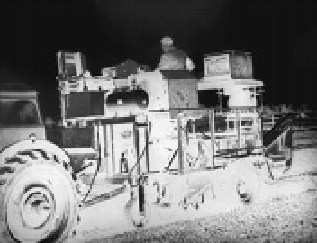Information Technology Reference
In-Depth Information
there was a market for small, inexpensive machines he called
minicom-
puters
. Many of the computational problems required by the business and
the research community were actually relatively small, such as calculat-
ing a payroll or monitoring an experiment. So in 1957, Olsen, his col-
league Harlan Anderson, and Ken's younger brother Stan decided to go
into the computer business for themselves. With several thousand dollars
of their own money, supplemented by funds from a Boston investment
firm, they set up the Digital Equipment Corporation - also known as DEC
and later just as Digital - in a Civil War-era wool mill just outside Boston,
Massachusetts. Three years later, they produced their first computer, the
Programmed Data Processor model 1, commonly known as the PDP-1.
This machine cost $120,000 and provided much more cost-effective com-
puting than was then available from IBM and others. DEC's business really took off with the introduction
of the PDP-8 in 1965, generally regarded as the first minicomputer (
Fig. 8.22
). The PDP-8 machine used tran-
sistors and magnetic core memory and cost $18,000. It could only run one program at a time and had less
memory than a mainframe computer, but it became the first commercially successful minicomputer. The
key selling point was its price and ability to be easily coupled with laboratory instruments for experimenta-
tion and control. Because of the low cost of the PDP-8, many more customers could afford to buy their own
computer to do their routine computational tasks. As computer historian Stan Augarten reports in his 1984
topic
Bit by Bit:
Fig. 8.22. A PDP-8 on a tractor used for
controlling sowing.
Scientists ordered PDP-8s for their laboratories; engineers got them for their offices; the Navy installed them
on submarines. In refineries, PDP-8s controlled the flow of chemicals; in factories, they operated the machine
tools; in warehouses, they kept track of inventory; in computing centers, they ran programs that didn't require
the power of a mainframe; in banks, they kept track of accounts. The notion of the information utility gave
way to
distributed processing
. For example, a bank would install a minicomputer in each of its branches; the
machines handled the branches' transactions during the day and sent records of their transactions to the
bank's central computer at closing time. The applications were endless.
35
While Bob Metcalf was a graduate student at MIT and Harvard, DEC lent him a PDP-8. It was stolen from his
lab and he had no idea how he could repay DEC. However, the company took the news in its stride and ran
an advertisement for the PDP-8 as “the first computer small enough to steal.”
36
In 1965 DEC pursued a second path for low-cost, interactive computing by introducing the PDP-6 as
the first commercial time-sharing system. This used many of the concepts and functions of MIT's CTSS soft-
ware and also DEC's experience with a time-shared PDP-1 at BBN, specially designed for Licklider. Introduced
in 1965 and the forerunner of the PDP-10, the PDP-6 was a 36-bit, time-shared mainframe computer with
roughly the same power as the IBM 709X and 110X series mainframe batch computers. Thus DEC grew
rapidly, beginning in the mid-1960s and through the 1970s along two paths: classical minicomputers like
the PDP-8 and PDP-11 (introduced in 1970), and the PDP-10 time-shared computers that could support one
hundred or more active users and were used by universities and by time-sharing service companies. The
PDP-10 ran a time-sharing system called TOPS-10. The Computer Center Corporation or “C-Cubed” installed
one of the first PDP-10s in the Seattle area in 1968. To help debug the system, the company offered free time
on the computer to a couple of local teenagers named Paul Allen and Bill Gates. In the early 1980s, the two
paths were covered by the PDP-11 minicomputers that used single chip microprocessors, and the VAX-11
computers that were typically time shared and could be used in clusters. By 1980, almost one hundred com-
panies had started building minicomputers using integrated circuits. By 1985, only six of these companies
remained.



Search WWH ::

Custom Search